In this Post
From the
Editor
Passage: William John ‘Qimmiliriji’ Carpenter
QIA, Canadian Government Settlement
Media review: Red Serge and Polar Bear Pants
Media review: One Day in the Life of Noah Piugattuk
Update: A Book is Born
Passage: William John ‘Qimmiliriji’ Carpenter
QIA, Canadian Government Settlement
Media review: Red Serge and Polar Bear Pants
Media review: One Day in the Life of Noah Piugattuk
Update: A Book is Born
Navigating This Site
Index of articles by subject
Index of Journal editions by
volume number
Index of PostScript editions by publication number
Search The Fan Hitch
Articles to download and print
Ordering Ken MacRury's Thesis
Our comprehensive list of resources
Defining the Inuit Dog
Talk to The Fan Hitch
Shop & Support Center
The Fan Hitch home page
Index of articles by subject
Index of Journal editions by
volume number
Index of PostScript editions by publication number
Search The Fan Hitch
Articles to download and print
Ordering Ken MacRury's Thesis
Our comprehensive list of resources
Defining the Inuit Dog
Talk to The Fan Hitch
Shop & Support Center
The Fan Hitch home page
Editor's/Publisher's
Statement
Editor: Sue Hamilton
Webmaster: Mark Hamilton
The Fan Hitch Website and
Publications of the Inuit Sled Dog– the
quarterly Journal (retired
in 2018) and PostScript – are dedicated to the
aboriginal landrace traditional Inuit Sled
Dog as well as related Inuit culture and
traditions.
PostScript is
published intermittently as
material becomes available. Online access
is free at: https://thefanhitch.org.
PostScript welcomes your
letters, stories, comments and
suggestions. The editorial staff reserves
the right to edit submissions used for
publication.
Contents of The Fan Hitch Website and its publications are protected by international copyright laws. No photo, drawing or text may be reproduced in any form without written consent. Webmasters please note: written consent is necessary before linking this site to yours! Please forward requests to Sue Hamilton, 55 Town Line Rd., Harwinton, Connecticut 06791, USA or mail@thefanhitch.org
Contents of The Fan Hitch Website and its publications are protected by international copyright laws. No photo, drawing or text may be reproduced in any form without written consent. Webmasters please note: written consent is necessary before linking this site to yours! Please forward requests to Sue Hamilton, 55 Town Line Rd., Harwinton, Connecticut 06791, USA or mail@thefanhitch.org
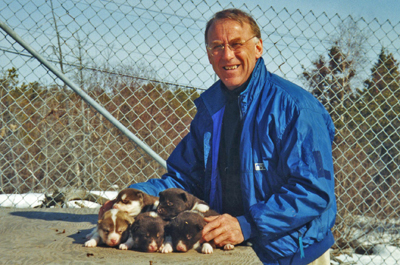
At his Yellowknife kennel, Bill with pups just over two weeks-old
photo: Carpenter collection
William John ‘Qimmiliriji’ Carpenter
1942 - 2019
“A long time ago, sometime between 1976 and 1978, some Inuit Elders (mainly ladies) from Eskimo Point, now known as Arviat, were visiting me in Yellowknife. We sat on the floor in my living room with one of my male dogs, then also with a female dog. The ladies were showing me how they measured with their hands for the proper sizing for making traditional Inuit dog harnesses. During our discussions about their history with dogs, they told me through an interpreter that they “used to be the dog people” but were no longer that. When we later went outside they wrote something in syllabics with a large marker on the bulletin board sign I had near the wooden stairs leading up to the large holding cages for my dogs. They said what they wrote was my name. When I asked through their interpreter, how does that say “Bill Carpenter”? They laughed and laughed saying “... It does not say ‘Bill Carpenter’. It says ’Qimmiliriji’ which is what we call you, and it means ‘The Dog Man’.”A noteworthy figure in the history of the Inuit Sled Dog is gone. ’Qimmiliriji’, The Dog Man passed away on October 19 at the age of 77 years in Lethbridge, Alberta, Canada, far in distance and time from when, in his Yellowknife home, he and close friend, the late John McGrath, decided someone should do something about the alarming drop in the population of the Eskimo dogs in the Canadian North. Over a fifth of rum, the two men decided that they would be the ones to undertake the task that would become known as the Eskimo Dog Recovery Project which began in the early 1970s.
WJC
There are many websites maintained by Canadian Kennel Club registered Canadian Eskimo Dog enthusiasts which offer no more than short shrift of the endeavor’s history. Surely the work deserves more attention than that. The energy, challenges, the highs and lows of that work were enormous. Many details of this history have appeared in traditional print form: three times in Dogs in Canada (January 1976; the 1990 annual; date unknown), in a fabulous issue of north/nord (February 1976), twice in the New York Times (November 1976 and January 2001). Some of these were written by journalists, some by Bill himself. Probably most of the nitty gritty anecdotes, and there must have been many, never made it to the main stream media. In January 1998 John “Umelik” (the bearded one) McGrath travelled from his home in Renfrew, Ontario to Massachusetts to present the recovery project history at the annual meeting of the Yankee Alaskan Malamute Club*. John was quick to mention that the talk was done in concert with Bill and went on to credit Bill with the bulk of the recovery project’s work and success. Two videos similarly describing the Eskimo Dog Recovery Project are: Dog of the Midnight Sun and Qimmiq.
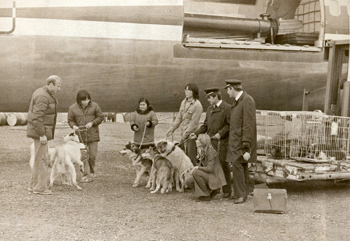 |
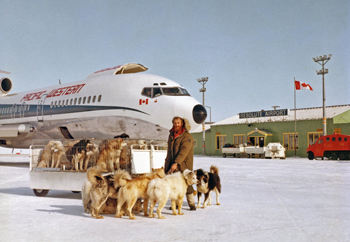 |
| Bill (l) with dogs, flight crew of Pacific Western Airlines and Inuit including the young Inuk man (standing third from right) who accompanied the dogs to Reid Island .photo: Carpenter collection | Bill
at the Resolute, NWT (now Nunavut) Airport with
dogs he had purchased ready to depart for
Yellowknife on a Pacific Western Airlines sponsored flight. photo: Carpenter collection |
Bill had many dogs in 1999 at his Bowspringer Kennels where we first met face-to-face when he graciously invited us to visit his then Yellowknife, NWT home on our way back from Ikalutuuttiaq (Cambridge Bay), Nunavut. Well into the wee hours of the morning, with the sky still on fire courtesy of the northern lights, Bill shared some tales. Two in particular stood out. A couple had relocated to Yellowknife with their two much loved saddle horses. But not long after settling there, a drunk from town shot and killed the horses thinking they were moose. The owners were devastated not only by the loss of their animals but also with the mind boggling prospect of how to dispose of their carcasses. Bill, trying to be a sympathetic neighbor to the recently arrived couple, came to offer his condolences at their loss and to take the horses and bury them. The couple was grateful for the generous offer and agreed. These were lean (pun intended) times for the recovery project. You can imagine what actually happened to those horses.
Part of the work of the recovery project involved the selection of authentic, traditional dogs, their acquisition and transfer to the Yellowknife breeding facility. The selection of candidates was made in part on the basis of their phenotype. Now, the original reason for beginning the project was Bill and John’s observation of the dwindling number of traditional dogs. The reasons for that were many, but one was the number of non-aboriginal landrace dog DNA contaminating the traditional dogs. After a few generations down one line of dogs Bill was breeding, some white pups in a litter looked very suspicious, so suspicious in fact that Bill suspected genetic contamination and, after examining his pedigree records, Bill described to us the “night of the long knives” where he identified every dog in his kennel from that suspect line and killed them all. Culling either under harsh arctic conditions or in the process of establishing a breeding program was and still is a fact of life, and death.
Bill wrote elsewhere about the project: “By the mid 1980s most of the dogs I had in Yellowknife were now registered with the Canadian Kennel Club (CKC) and it was time to wind down the large breeding program. With major financial support from the Government of the Northwest Territories (GNWT), I sent “registered” Canadian Eskimo Dogs (as they were and are still called by the CKC) to breeders in the NWT, Yukon, British Columbia, Alberta, Manitoba, Ontario and Quebec. Although I kept some dogs for my own personal use and to take guests out at Moraine Point Lodge it marked the end of a long and successful breeding program to save the breed from extinction and again have the dogs registered under the Livestock Pedigree Act of Agriculture Canada through the CKC.”
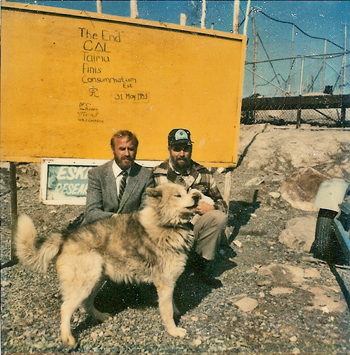
Bill (l) with John
McGrath (r) together in Yellowknife, May 31, 1983
as the Canadian Eskimo Dog breeding program was winding down.
Photo: Lara Carpenter
as the Canadian Eskimo Dog breeding program was winding down.
Photo: Lara Carpenter
In February 2010 Bill placed his last three dogs with an Inuit Dog mushing outfitter in the United States. He wrote: “Having raised over 1000 Inuit Dogs and trained and ran several 100 of them in teams since 1974; and had either a family pet dog when young or my own hunting dogs from 1956 to 1975, this indeed will be a new and different phase of life without dogs.” Bill not only was far away in time and geography when he eventually settled down in Lethbridge, Alberta. He also came a long, long way in regard to nomenclature since the early 70s. He had always referred to his dogs as Eskimo dogs. But when we re-connected several years later and began collaborating on his many contributions to The Fan Hitch Journal, he transitioned from calling them Eskimo dogs to Inuit Dogs. This had to have been quite a shift in terminology for him to make and I admired him greatly for it.
Bill Carpenter was not just Qimmiliriji. In 1971 he moved to the Northwest Territories (NWT) from Alberta first working as a biologist with the Government of the Northwest Territories (GNWT) and then later as a Senior Environmental Policy Advisor for the Executive Secretariat of the GNWT. In 1974 he brought full time veterinary service to the NWT by building a clinic and hiring the first resident veterinarians for the North. Bill was himself a so-called para-vet and on occasion he had to attend to the emergency needs of animal owners when his resident veterinarian was out of Yellowknife. For 21 years Bill provided this veterinary service to not only Yellowknife but all of the NWT. Mentioned in his obituary: In 1982, Bill and his associate John Bayly, constructed a wilderness retreat, Moraine Point Lodge, on the remote west shore of Great Slave Lake. For 5 1/2 years, Bill was the Environmental Director for the Metis Nation of the NWT. He was responsible for writing the research proposal on “Variance in Traditional Food Use in Metis/Dene Communities”. In 1997, Bill was appointed to the position of World Wildlife Fund (WWF)-Canada’s Regional Coordinator to manage the WWF “Endangered Spaces Campaign” in the NWT. In 2002, he was one of the northern recipients of the Queen’s Golden Jubilee Medal. In semi-retirement, he consulted for the WWF as the NWT Senior Advisor to WWF Canada, focusing primarily on the proposed (and now approved) Edehzhie National Wildlife Area. In 2018, Bill became a Board member of the Bowness Historical Society.
However, Bill may be best remembered as ‘Qimmiliriji’, for describing the Eskimo dog as “exhibiting an exaggerated response to all stimuli”. And in a January 2001 New York Times interview.] he stated, "The future of this dog is not with southern dog shows, not with pet owners on leashes. The future of this dog lies in its cultural setting. The future of the dog is in the hands of the northerners."
Words to live by.
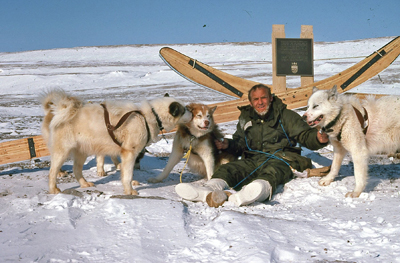
Bill sitting with some of his team in front of the cairn he erected on Cape Eyre on
the southeast tip of Prince of Wales Island where he ended his 29 day Stuart M. Hodgson
Canadian Eskimo Dog Sledging Expedition, April 1979 due to a cracked sledge runner.
photo: Carpenter collection
A selection of
resources by and about Bill Carpenter
AVAILABLE IN PRINT
Obituary
Taxonomy in Relation to the Inuit Dog and Major Historical References to the Breed by William J. Carpenter
Dealing with a Runaway or Breakaway Team of Inuit Dogs by William J. Carpenter
Raising Eskimo Dog Puppies for Use in a Fan Hitch by William (Bill) Carpenter “Qimmiliriji” (The Dog Man)
Major Virus Issues in Canada’s North and Canine Parvovirus Infects Inuit Dogs in Yellowknife, Northwest Territories, 1978 by William J. Carpenter
Canadian Inuit Dogs I have owned, raised and trained A photo essay; Part 1 by William J. ‘Qimmiliriji’ Carpenter
Canadian Inuit Dogs I have owned, raised and trained: A photo essay; Part 2 by William J. ‘Qimmiliriji’ Carpenter
Canadian Inuit Dogs I have owned, raised and trained: A photo essay, Part 3 by William J. ‘Qimmiliriji’ Carpenter
Canadian Inuit Dogs I have owned, raised and trained: A photo essay, Part 4 by William J. ‘Qimmiliriji’ Carpenter
AVAILABLE IN VIDEO
Dog of the Midnight Sun (documentary)
Qimmiq (documentary)
*Presentation by John McGrath at the Yankee Alaskan Malamute Club Annual Meeting in Massachusetts January 3, 1998 (prepared in concert with Bill Carpenter, Yellowknife, NWT). A DVD of that presentation was originally made available for sale with all proceeds donated to the Ilisaqsivik Society’s Qimmivut program in memory of John ‘Umelik’ McGrath. It is once again being made available to buy from The Fan Hitch for the cost of reproduction and mailing with all proceeds going to Ilisaqsivik Society’s Qimmivut program in memory of Bill ‘Qimmiliriji’ Carpenter.